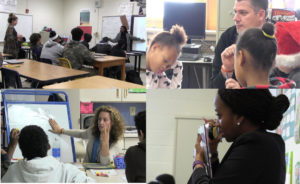
What does teacher-leadership look like when teachers lead a team while continuing to teach? For four pioneering multi-classroom leaders in high-need elementary, middle, and high schools, it starts with taking accountability for up to 500 students and leading a collaborative teaching team toward higher growth and personalized learning for all those students.
These teacher-leaders took on roles in some of the first Opportunity Culture® schools as multi-classroom leaders (MCLs). MCLs keep teaching while leading a team, providing support through co-planning, coaching, co-teaching, and team collaboration. In a new series of vignettes and an accompanying video from Public Impact®, these multi-classroom leaders share their view of their roles, the actions they took to lead their teams, mistakes they made, and how they recovered.
These MCLs’ actions differed somewhat, but several overarching themes emerged, including building strong teacher relationships and focusing on student learning data:
- Building strong teacher relationships: All the MCLs emphasize how, in varying ways, professional relationships mattered. For Charlotte MCL Erin Burns, that meant establishing trust in her methods among a team of veteran teachers wary of her youth and her new role. For Nashville MCL Karen Wolfson, it meant earning her team’s esteem as a teaching role model and advocate for them, and building strong relationships with the schoolwide team of MCLs, who helped her improve and excel. For Charlotte MCL Ashley Jackson, a self-professed introvert, it meant a carefully planned schedule to ensure enough time with her team to support them reliably. And for Syracuse MCL Russ Stanton, it meant establishing trust and credibility with his team, providing a safe space to air concerns and vulnerabilities that let the team coordinate instruction.
- Focusing on student learning data: Likewise, the MCLs agree that leading their teams in analyzing and using student data is a crucial component to personalize their students’ instruction. “The team sits down together regularly, with actual student work in hand, to determine what to do when the data reveals major issues,” Jackson said, noting that the team was willing to follow her lead because of her accountability. “In other coaching-type roles, coaches aren’t formally accountable for the growth of their teams. Those coaches aren’t pushed to go the extra mile the way I am, and my team teachers can see that. They know that their success is my success, literally, because their evaluations will be reflected in mine.”
- And more, including choosing team members wisely (when possible), helping teachers improve lesson plans and classroom instruction, standing up to protect their teams’ time, and using the schoolwide MCL structure to communicate consistently.
Multi-Classroom Leadership has been the most popular—and highest paid—model that Opportunity Culture® schools have used to extend the reach of their excellent teachers to more students within recurring budgets. Team teachers report positive experiences from the support they receive from their MCLs. Early Opportunity Culture® schools achieving the largest, fastest gains schoolwide had multi-classroom leaders schoolwide in core subjects. Their principals formed a team of leaders of these MCLs (and sometimes assistant principals) to lead instruction schoolwide. Forthcoming tools will provide guidance to help other MCLs and principals emulate the methods of the highest-performing Opportunity Culture® schools.
These vignettes are the second installment in a series looking at the actions of Opportunity Culture® principals, MCLs, and blended-learning teachers. See more vignettes and case studies here.
Note: Public Impact® and Opportunity Culture® are registered trademarks; Multi-Classroom Leader®, Multi-Classroom Leadership™, and MCL™ are trademarked terms, registration pending.
